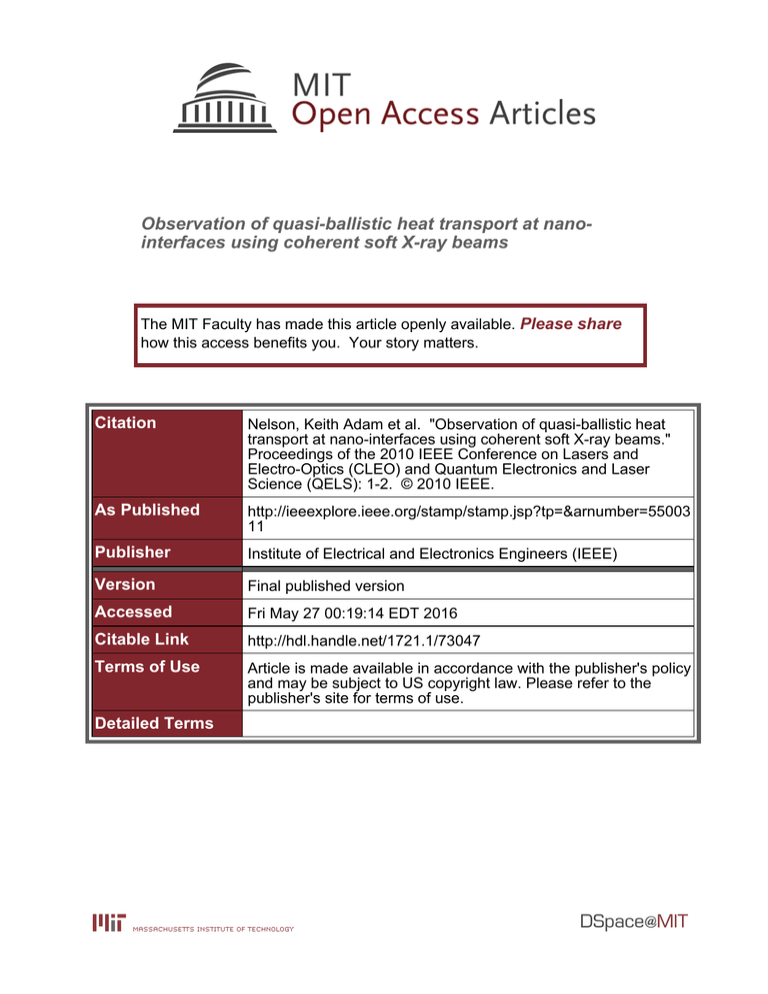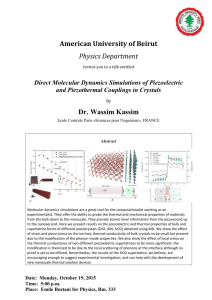Observation of quasi-ballistic heat transport at nano- Please share
advertisement

Observation of quasi-ballistic heat transport at nanointerfaces using coherent soft X-ray beams The MIT Faculty has made this article openly available. Please share how this access benefits you. Your story matters. Citation Nelson, Keith Adam et al. "Observation of quasi-ballistic heat transport at nano-interfaces using coherent soft X-ray beams." Proceedings of the 2010 IEEE Conference on Lasers and Electro-Optics (CLEO) and Quantum Electronics and Laser Science (QELS): 1-2. © 2010 IEEE. As Published http://ieeexplore.ieee.org/stamp/stamp.jsp?tp=&arnumber=55003 11 Publisher Institute of Electrical and Electronics Engineers (IEEE) Version Final published version Accessed Fri May 27 00:19:14 EDT 2016 Citable Link http://hdl.handle.net/1721.1/73047 Terms of Use Article is made available in accordance with the publisher's policy and may be subject to US copyright law. Please refer to the publisher's site for terms of use. Detailed Terms OSA / CLEO/QELS 2010 a1881_1.pdf CThQ4.pdf Observation of Quasi-Ballistic Heat Transport at Nano-Interfaces using Coherent Soft X-Ray Beams Qing Li, Mark E. Siemens, Ronggui Yang, Margaret M. Murnane, Henry C. Kapteyn Department of Physics and JILA, University of Colorado, Boulder, Colorado Erik H. Anderson, Lawrence Berkeley Labs and Center for X-ray Optics, Berkeley, California Keith A. Nelson Massachusetts Institute of Technology, Cambridge, Massachusetts Email: qing.li@colorado.edu Abstract: We make the first observation and quantitative measurement of quasi-ballistic thermal transport from a nanoscale heat source, finding a significant decrease in energy transport away from the hotspot compared with diffusive thermal transport predictions. OCIS codes: 320.7150 Ultrafast spectroscopy; 300.6430 Spectroscopy, photothermal The Fourier theory of thermal transport considers heat transport as a diffusive process, where energy flow is driven by a temperature gradient. However, this is not valid at length scales smaller than the mean free path for the energy carriers in a material, which can be hundreds of nanometers in crystalline materials at room temperature. In this case, heat flow will become 'ballistic'—driven by direct point-to-point transport of energy quanta [1]. Past experiments have demonstrated size-dependent ballistic thermal transport through nanostructures. This Fourier law should also break down in the case of heat dissipation from a nanoscale heat source into the bulk (see Fig. 1). However, despite considerable theoretical discussion and its direct relevance to thermal management in nanoelectronics [2] and in nano-enabled energy systems [3], this non-Fourier heat dissipation has not been experimentally observed to-date. Here, we accurately measure thermal transport from a nanoscale hotspot into a bulk material using ultrafast diffraction of coherent high harmonic soft x-ray light from a nanostructured surface. We observe ballistic thermal transport at the interface, manifested by a decrease in energy transport compared with the diffusive Fourier law prediction. Our results show that the Fourier law can be corrected to describe energy dissipation from nanostructures into the bulk by introducing a size-dependent ballistic thermal resistance. This finding could have significant impact on the thermal management and reliability of emerging nanoscale devices, and nano-enabled energy systems. Fig. 1: Schematic illustrating the difference between diffusive and Fig. 2: Sample geometry showing the infrared laser quasi-ballistic thermal transport. illumination and soft X-ray detection scheme. 978-1-55752-890-2/10/$26.00 ©2010 IEEE a1881_1.pdf CThQ4.pdf OSA / CLEO/QELS 2010 In these experiments, we study conduction cooling of nickel nanowires on a sapphire substrate. We use sapphire because it has a long phonon mean free path (Λ~150nm at room temperature). As a reference, we also used fused silica substrates, since this material has a very short mean free path (Λ~2nm). The sample has several arrays of 20nm high nickel strips, with linewidths L varying between 2µm and 65nm. We take ~25 fs, 800nm light from a Ti:sapphire laser amplifier as a pump beam to heat only the nickel nano-lines, generating a nanoscale heat transient (see Fig. 2). We probe the thermal expansion and subsequent thermal relaxation by measuring the dynamic diffraction changes of ~30nm soft x-ray light generated using high harmonic generation of the same ultrafast Ti:sapphire laser. Fig. 3: Measured effective interface thermal resistivity for nickel nanostructures of width L deposited on fused-silica (Λ~2nm) (blue color) and sapphire substrates (Λ~150nm) (red color). The experimental results are shown in Fig 3. We observe a significant effective increase in interface resistivity with decreasing line width (red dots) for the case of the sapphire substrate compared with the bulk resistivity value rTBR (shown as a red dotted horizontal line). In contrast, no change in resistivity is observed for a fused silica substrate (blue dots). We find excellent agreement between the experimental data and an analytical model (blue and red dashed curves). This shows that the Fourier law can still be used if corrected with an extra size-dependent resistance, proportional to Λ/L (phonon mean free path/linewidth). We also present a systematic study including polarization dependence of the thermal transport, as well as results from similar measurements using a silicon substrate. These experiments further advance the understanding of heat-transfer fundamentals, and are important for the design and manipulation of nanoscale thermal transport in circuits, thermoelectrics, photo-voltaics and other structures of interest in nanotechnology. References [1] Chen, G., Borca-Tasciuc, D. & Yang, R. G., “Nanoscale heat transfer,” Encyclopedia Nanosci. Nanotechnol. 7, 429-459 (2004). [2] Pop, E., Sinha, S. & Goodson, K. E. “Heat generation and transport in nanometer-scale transistors”. Proc. IEEE 94, 1587-1601 (2006). [3] Poudel, B. et al. “High-thermoelectric performance of nanostructured bismuth antimony telluride bulk alloys.” Science 320, 634-638 (2008). [4] Mark Siemens, Qing Li, Ronggui Yang, Keith Nelson, Erik Anderson, Margaret Murnane and Henry Kapteyn, “Quasi-ballistic thermal transport from nanoscale interfaces observed using ultrafast coherent soft X-ray beams,” Nature Materials, doi:10.1038/nmat2568, (2009).






